If you’re a marketer in 2023, all you can see around yourself are painstakingly comprehensive articles on the collapse of third-party cookies, the critical importance of data privacy, and Media Mix Modeling. While the first two of the list are most talked about in the past two years, it’s the Media Mix Modeling that’s being hailed as the beacon of data-driven marketing in this new data-private world. Many industry experts predicted the return of this decades-old strategy in 2023 and here we are!
In this detailed guide on Media Mix Modeling, let’s unravel the nitty gritty of MMM and how marketers like yourself can master it as a robust alternative to cookie-dependent marketing to optimize your marketing spend, fine-tune your strategies, and never feel the data-void post the third-party cookies demise.
Before conquering the MMM battleground, you need to know what Media Mix Modeling is, its brief history, how it came into existence, and why it resurfaced several years later.
What is Media Mix Modeling (MMM)?
Media Mix Modeling is a statistical model used by marketers to gauge the impact of media and advertising channels on business outcomes – sales and revenue. It uses multi-linear regression to understand how different channels like television, outdoor marketing, digital, print, etc. are working to generate business for a company. The model helps businesses to make data-backed decisions and invest more in channels that work best for them.
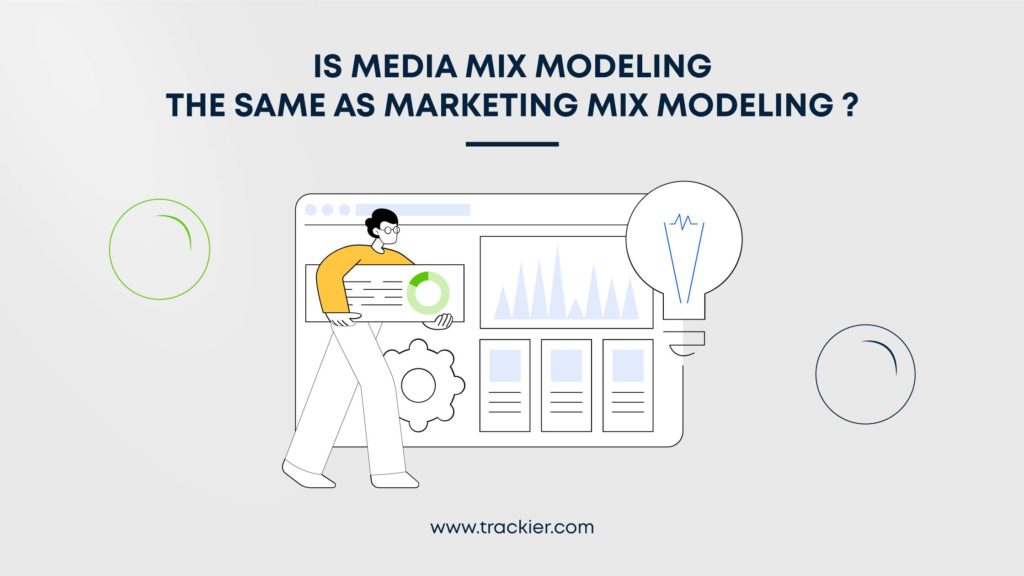
Media Mix Modeling & Marketing Mix Modeling – The Difference
Media Mix Modeling is often used interchangeably with Marketing Mix Modeling, however, they aren’t exactly the same. Marketing Mix Modeling is a broader term that is used to analyze the impact of marketing initiatives on business outcomes. The key difference is that Media Mix Modeling focuses only on media channels while Marketing Mix Modeling considers all the marketing elements including channels, pricing, placement, etc.
Marketing Mix Modeling offers a more comprehensive understanding of the impact of marketing initiatives on business outcomes, as compared to Media Mix Modeling.
Brief History of the Media Mix Modeling
To understand why Media Mix Modeling became popular in the first place, it is important to know where it came from and how. Introduced in the 1950s by the retail industry, it only became popular in the 60s and 70s. One of the early adopters of MMM was Kraft Foods who used this type of analysis when they launched Jell-O. Using this technique, they were able to narrow down three to four networks and magazine advertising to promote their new launch.
Ever since then, it was widely used by marketers for its ability to combine first-party data like leads, ad spend, and revenue with external factors like macroeconomic conditions, festivals, competitor activities, and seasonality.
But it wasn’t always sunny for Media Mix Modeling. It had its limitations – lack of immediacy, granularity, and transparency that UA managers need to call the shots on budgets and campaigns. Also, MMM requires two years or more of data to adequately offer what was a bird’s eye view of advertising effectiveness.
Enter Data Attribution, marketers are hugely benefited from its capabilities to analyze a campaign at a granular level- including user interactions, engagement, etc. It offered what MMM lacked – a look into the customer’s journey.
Then what happened in 2022 and beyond, that Media Mix Modeling is being deemed as a ray of hope? Let’s discuss it further.
The Resurgence of MMM: What Sparked its Comeback?
It all started in 2021 with Apple’s App Tracking Transparency (ATT) Framework – according to this, marketers cannot access user-level data on iOS anymore, unless a user opts in for it. Following the suit, Google also announced the gradual phasing out of third-party cookies and limit sharing the user data on Android to third parties via its Google Privacy Sandbox. In fact, the third-party cookies’ obsolescence will begin from Q1 2024 itself.
With this, the two OS giants have sent out a message loud and clear – data privacy is the new thing and it’s here to stay. That’s where MMM swoops in like a privacy-friendly hero.
In the 60s, marketers, and statisticians spent a great deal of time performing Media Mix Modeling analysis using traditional econometric tools like linear regressions. Some even did it by hand, which took time and patience. Over the years, campaign data have become more complex and marketers need instant results. This led to the decline of MMM.
Fast forward to many years later, thanks to the advancement of technology and machine learning, the whole process is much simpler. Some tools even allowed users to simply feed their conversion data into a data science workflow and get results.
All this led to the great renaissance of the MMM.
How Does Media Mix Modeling (MMM) Work?
Media Mix Modeling uses multi-linear regression to form a relationship between dependent variables like business outcomes and independent variables like advertising spending across channels. It establishes how a change in ad spend can directly impact sales or engagement.
For MMM to work, organizations need to aggregate and clean data from their internal or third-party sources or sometimes both. It requires up to 2-3 years’ worth of data to also factor in seasonality and external events.
With MMM, marketers can assign a numerical value to the impact of campaigns across media channels toward achieving their business objectives, be it sales, engagement, or lead generation.
Here’s an infographic to put it simply.
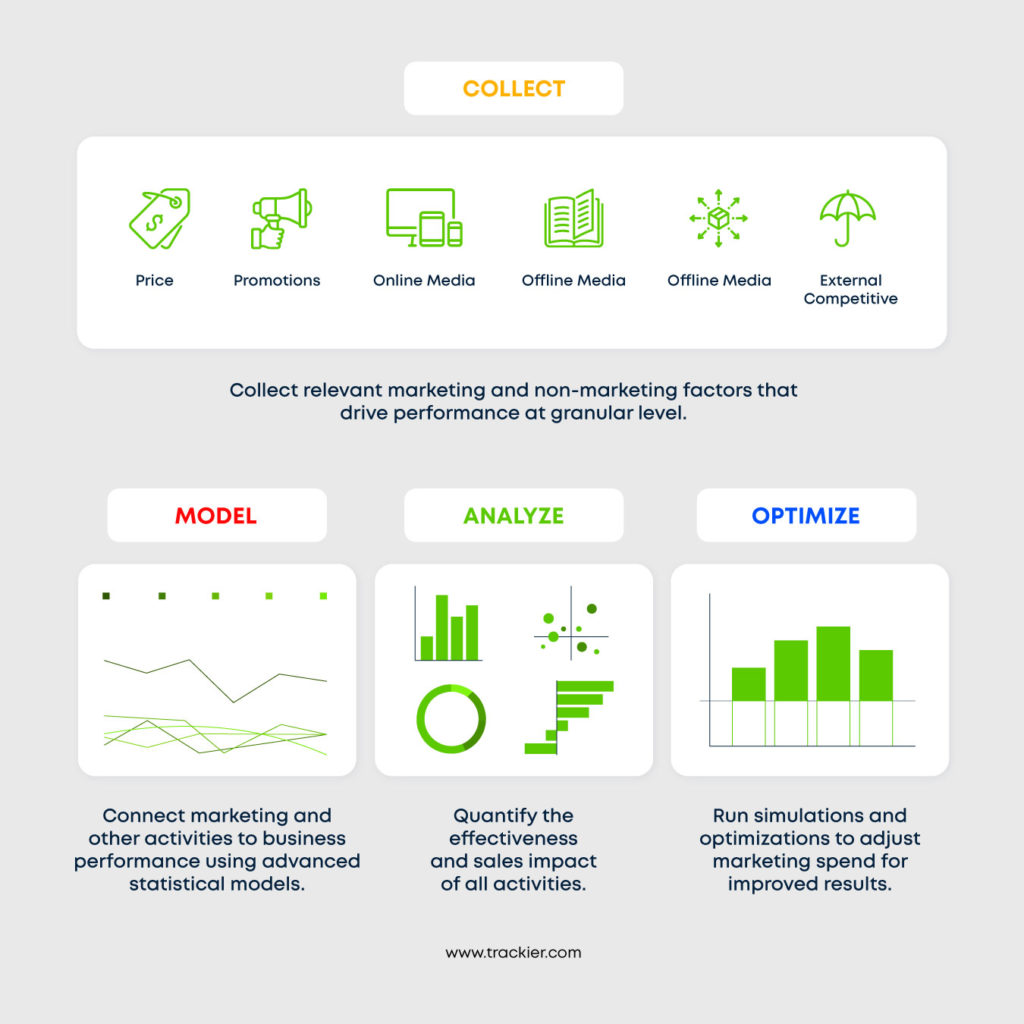
What is Media Mix Modeling Ratio?
There are three components to a Media Mix Modeling Ratio for an organization:
- Media channels in a campaign
- Money being invested in each channel
- Campaign results
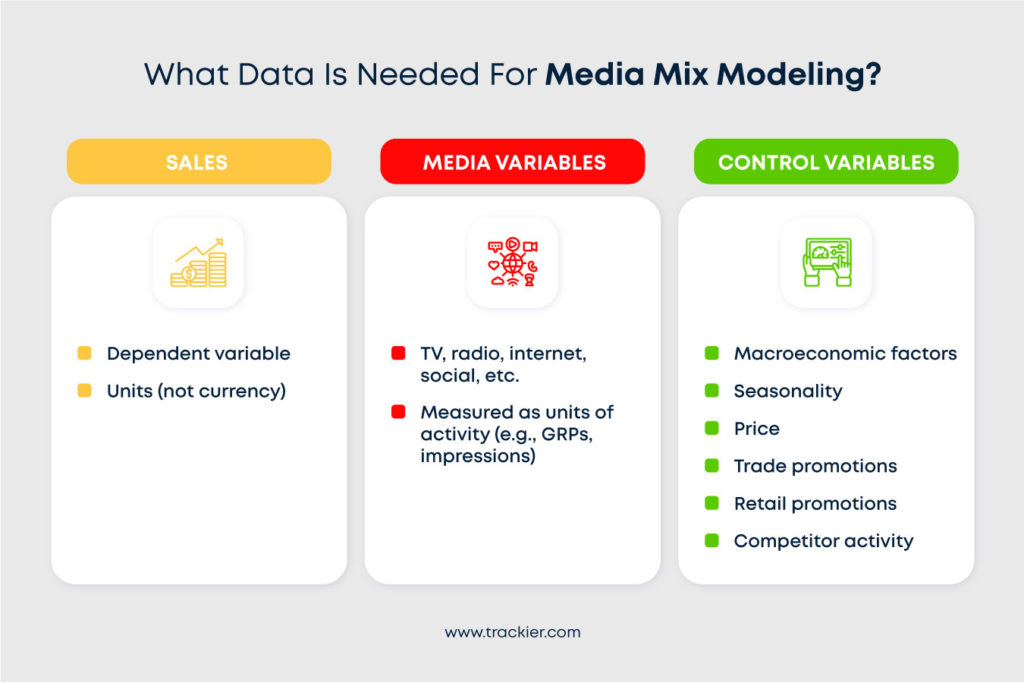
Media Mix Modeling & Its 3 Variables
There are three variables in Media Mix Modeling as given below;
- Sales – Sales or a dependent variable is defined in terms of units (not currency) to measure the demand for the product or service.
- Media Variables – Media variables are used to measure the impact of a media channel on the unit sales (sales variable mentioned above). Media variables, like sales, are to be measured in units of activity.
- Control Variables – As we mentioned earlier in the guide, we need a measure of those things that are directly impacting sales, including macroeconomic variables.
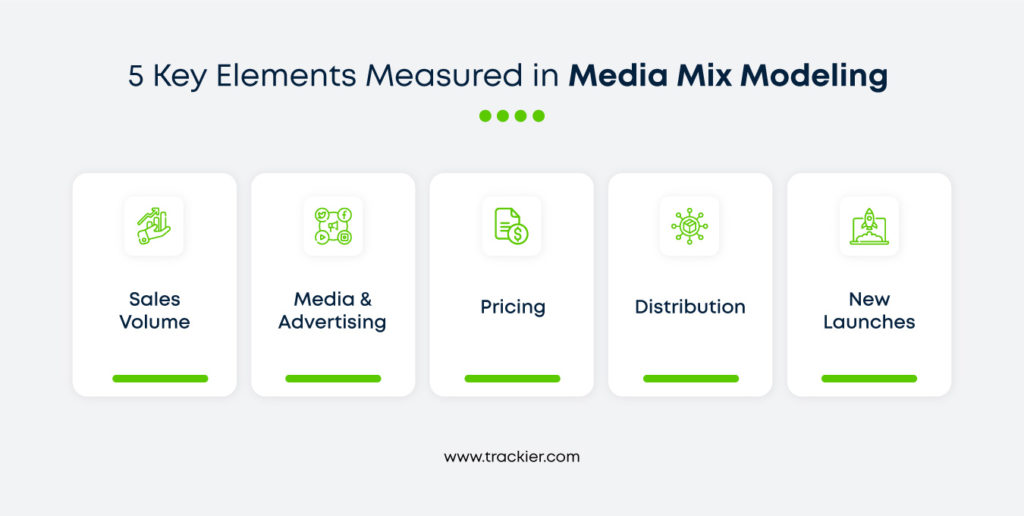
Key Elements Measured in Media Mix Modeling
There are 5 key elements that are measured when using Media Mix Modeling. Let’s understand them in detail.
1. Sales Volume
There are two types of sales that are taken into account when using MMM – base sales and incremental sales. Before moving forward, let’s quickly understand what they are.
Base Sales are the sales driven by base parameters like pricing, long-term trends, seasonality, brand awareness, and brand loyalty. They are influenced by economic factors and seasonality. On the other hand, Increments Sales are the sales driven by marketing and advertising activities. This type of sales is directly influenced by each marketing activity.
Incremental sales are calculated to understand the portion of sales driven by marketing efforts.
2. Media and Advertising
Media Mix Modeling analyzes the sales driven by media and advertising on different media including television, digital, and print. Though the model doesn’t produce definite insights, it offers valuable insights into how outcome (sales) changes due to adjustments in advertising strategies.
The adjustment can include but are not limited to,
- Comparing Ad Lengths: Evaluating the effectiveness of 15-second versus 30-second ad executions.
- Platform Comparison: Assessing the outcomes of running ads on different platforms.
- Time Slot Impact: Analyzing the effects of airing ads during prime-time versus non-prime-time hours.
3. Pricing
As it is known to everyone, any change in pricing structure can directly affect sales volume. The effect can be seen and understood with the help of MMM. Businesses can establish a relationship between the percentage of change in sales volume and the percentage of change in the pricing to make better decisions, so as to do good business while being affordable to customers.
4. Distribution
One can’t imagine doing business without a distribution system in place. Promoting the business exactly where the target audience is, at the right time, drives growth like nothing else. With the help of Media Mix Modeling, marketers can understand how each channel is bringing sales to the business. Using the MMM, they can identify the channel most important for the business and the ones they can forego.
5. New Launches
Often a new launch results in better growth and has a direct impact on sales. A successful launch means peaked sales volume. With MMM, one can measure the success of the latest launch by quantifying its impact on various sales metrics.
Media Mix Modeling Examples
What’s a better way to understand a complex topic than a real-world example? To simplify Media Mix Modeling, here are some real-world use cases of MMM.
Example 1
There’s a hospitality brand that wants to identify the media channel that contributes the most to sales. They run both Search and Social Media Ads and want to know where they should invest more. They will collect sales data from a specific time frame – ideally 2 or 3 years. Using MMM to run a multivariate test, they can identify how sales change when changing the media channel.
Example 2
Picture a company selling its products in various parts of the world. They’re eager to figure out which marketing efforts are boosting sales in specific regions. They need to divide their marketing budget for different channels – think Google paid search versus Bing. Using MMM, they analyze their data and try to unveil insights without any marketing input.
Pro Tip: Take into account at least two years of data to have at least two seasonal cycles.
Media Mix Modeling vs. Attribution Modeling
While we’ve explained above at great length what Media Mix Modeling is, let’s talk about data-driven attribution modeling. Data-driven attribution modeling includes multiple attribution models like single-touch attribution and multi-touch attribution. It is used to analyze user-level engagement with various touchpoints in the customer journey and attribute the conversion to each touchpoint.
Both MMM and data-driven attribution models give you a picture of how your marketing activities affect your business outcomes like sales, revenue, etc. Both of them use statistical and mathematical models to analyze data.
However, MMM flies above the surface, while the data-driven attribution model lets you see the user-level engagements as well. On your Mobile Marketing Platform or Performance Marketing Software, you can track person-level data including clicks, impressions, installs, and add to cart, while this isn’t possible using Media Mix Modeling.
To put it simply, here’s a table to tell one from another.
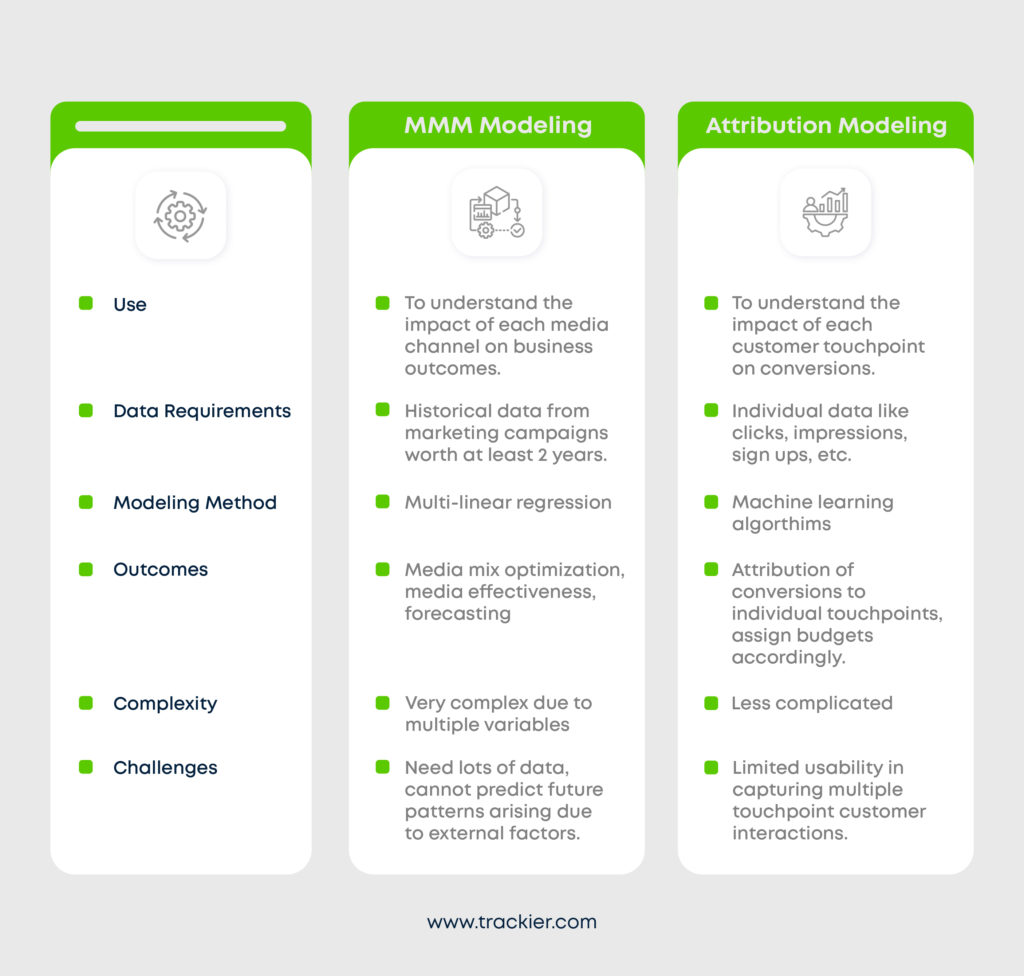
Can Media Mix Modeling Fill the Third-Party Cookie Void?
The clock is ticking and in a matter of a few months, the browsers including our very dear Google Chrome, are going to pull the plug on third-party cookies. Hitherto, brands have relied on third-party cookies to find their ideal customers, understand their preferences and target them with relevant offers. But it can no longer continue because one thing is for sure our customers love data privacy and regulations are only going to get more stringent in the near future.
Marketing Mix Modeling is ‘one’ such method that can fill the cookie-less void. Pay attention to the term ‘one’. This implies that MMM alone can’t be used by marketers to gauge the impact of their marketing activities on their business outcomes. It’s one of the good alternatives, a good crutch even, but it cannot build the whole staircase alone.
Here’s what you can do.
Use a concoction of Context-based Targeting, Media Mix Modeling, Geographic Testing, Incrementality Measurement, and Advertising Testing to form a holistic picture without third-party cookies. There’s no single solution to cookie death, but focusing on behavioral data instead of user-level data can inform you how you should spend your marketing dollars.
Will the MMM work for your business?
So at this stage, we know that Media Mix Modeling is one of the knights in shining armor to sway marketers away from the third-party cookies dilemma. But is it for everyone?
The answer is yes if the below-mentioned conditions hold true for your business.
- You have lots of data and your data is segregated because ML requires big chunks of ‘clean’ data.
- You are aware that media changes with time and historical data may not accurately predict how they may behave in the future.
- You’re just looking for a high-level look into your marketing channels’ effectiveness and have other ways to get more granular insights.
You’d like to give MMM a miss if…
- If you’re a small or new business with not much historical data, it’s advisable to wait for some time before you board the MMM ship.
- If your business belongs to a highly dynamic market with rapid changes, sudden trends, etc, MMM might not be able to provide you with reliable insights.
- Your business is in a very niche market with very limited media channels to work on, it’s imperative that you give MMM a miss.
- If your marketing campaigns are of short durations, it’s hard to get historical data. Sporadic campaigns might not yield enough data for accurate analysis.
- If you run on a very tight budget since it won’t be wise to allocate resources to this type of analysis.
- If immediate results are what you’re looking for. Media Mix Modeling provides insights into the long-term effect of marketing efforts.
How to Get Started with Media Mix Modeling?
If you’re ready to take the next step towards MMM, here’s a roadmap to give you a headstart.
Note: If you don’t have a degree in data analytics and you aren’t planning to have it in the future, it’s advisable to get a data analyst onboard or invest in a high-quality Media Mix Modeling tool.
- Define your KPIs – Clearly outline your goals and what you want to achieve with Media Mix Modeling. Are you looking to optimize your advertising budget? Do you want to understand channel performance?
- Get data – Gather historical data on your marketing channels, including ad spend, sales, traffic and other relevant metrics. Take at least 2 years of data to factor in seasonality and trends.
- Clean the data – As we’ve mentioned above, Media Mix Modeling requires heaps of clean data. Clean the data to remove inconsistencies, outliers, and missing values that could hamper the results.
- Select variables – Identify the dependent variable and the independent variable that you want to analyze.
- Choose a model – Select the modeling technique depending on your data and objectives. Common techniques include linear regression, time series analysis, and ML algorithms.
- Develop a model – Build the media mix model using the technique. It involves training the model with historical data to get the correct relationship between marketing activities and business outcomes.
- Validation & testing – Split your data into training and validation sets to gauge the model’s accuracy. Adjust parameters and model as required to get it right on track.
- Study the results – Analyze the model’s coefficients and statistical significance to strike a relationship between each marketing channel and your objectives.
- Scenario analysis: Include what-if scenarios to understand the impact of different situations like budget change, channel inclusion (or exclusion) on your outcomes.
- Implement insights: Based on the analysis, optimize your marketing budget allocation, adjust strategies, and make informed decisions to maximize ROI.
- Monitor and refine: Continuously track and compare actual results with model predictions. Refine the model over time as new data becomes available and market dynamics change.
In a Nutshell
While Media Mix Modeling alone might not fill the measurement void left by the death of third-party cookies, it can be coupled with other techniques including incrementality analysis, advertising testing, data partnership, and enrichment of first-party data for a more data-driven marketing approach.
For brands and app marketers running ads on large budgets and multiple channels, MMM is a must-not-miss strategy to gain a predictive insight into what might work and how budget adjustments can impact their marketing objectives. However, for businesses that are just starting out with a limited budget and not much scope for experimentation, MMM might be an option for them but in a much later stage.
Talking about larger corporations like Fortune 500, MMM is already being adopted as one of the core techniques to understand their marketing campaigns and their effects on business outcomes. In fact, 40% of Fortune 500 brands are already deploying MMM to enhance their strategic decisions.



